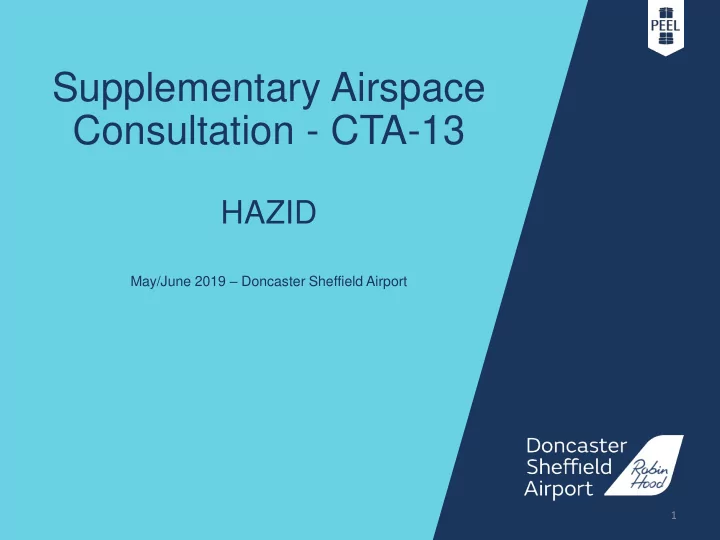

Supplementary Airspace Consultation - CTA-13 HAZID May/June 2019 – Doncaster Sheffield Airport 1
Scope Introduction Purpose Assumptions ROGAG SIDs and Airspace Containment Airspace Classification Options Hazard Identification and Analysis Next Steps
Introduction DSA submitted a CAP725 ACP to the CAA in May 2018; It proposed the introduction of PBN SIDs, IAPs and an additional CTA (CTA-13); The CAA requires that DSA consult aviation stakeholders on the options for the airspace classification associated with the proposed CTA; The purpose of this HAZID is therefore to assess the risks associated with aircraft operations within CTA-13.
Purpose Identify as many credible hazards as possible that could be presented by providing an ATS to IFR aircraft in CTA-13 (airspace classification tbd). Hazard Assessment – How safe does the airspace need to be? Risk Assessment Airspace Hazard (severity, Set Safety Description Identification probability, Objectives tolerability) Preliminary Airspace Safety Assessment – How safe can the airspace be? Safety Requirements Airspace Safety Assessment – How safe is the airspace? Airspace Implementation and Airspace Operation and IFP transfer to operations Maintenance
Assumptions Current level of risk presented by operations in Class D and Class G airspace is tolerable (in accordance with the ANSP’s SMS and statutory requirements). ROGAG SID procedures are designed in accordance with PANS-OPS regulations (obstacle and terrain clearance) and current controlled airspace containment policy. Operational Procedures will be defined for the implementation and through-life safety of the IFPs and the associated airspace.
ROGAG 1A SID
ROGAG 1C SID
Existing Airspace Class D CTR and CTAs CTR-2 SFC-FL105 CTA-2 1500-FL105 CTA-6 2000-FL105 CTA-3 2000-FL60
PC Airspace KEY ROGAG SIDs ATS Routes Existing DSA CTA/CTR ATS Route level change R313 R313 Buffer Zone ROGAG SIDs
The original Airspace Proposal Portion of L603/L60 to be lowered CTA-13
The original Airspace Proposal Outside scope In scope
The original Airspace Proposal – Cross Section CTA-13 In scope
Options for CTA-13 Option 1. Do Nothing, i.e. do not change the existing proposal of Class D airspace; Option 2. Change classification to Class E; Option 3. Change classification to Class E but add RMZ; Option 4. Change classification to Class E but add TMZ; (Preferred Option) Option 5. Change classification to Class E but add RMZ/TMZ;
Options Analysis # Option Traffic Controller CAT Pilot Access for Access for Access for Access for Transit Perceived Description Environment Workload Workload Non-RT (VFR) Non- equipped equipped traffic pilot Protection Transponder airspace airspace workload for ATC/CAT (VFR) users (VFR) users (IFR) and IFR transits 1 Class D 2 Class E 3 Class E RMZ 4 Class E TMZ 5 Class E RMZ/TMZ
Hazards Identification - Example Mitigations and Hazard Cause(s) Consequence Considerations ATC Systems ATC Procedures • • • Loss of GNSS Navigation Unintentional RF Inability for one or Onboard receiver Infrastructure (Signal in interference. more aircraft to fitted with • Space) RAIM Holes. perform horizontal RAIM/FDE position estimation algorithms • resulting in failure to SIDs designed follow the SIDs. according to PANS- • ATC workload OPS (safety increase. protection areas). GNSS SiS • • MAC (worst case Gross error checks scenario). and cross-reference navigation system for integrity and accuracy of lateral position database. • ATC services • Visual Flight Rules Airborne Systems Flight Crew Airspace and other Aircraft
Hazards Identification – Operations in CTA-13 Mitigations and Hazard Cause(s) Consequence Considerations ATC Systems ATC Procedures GNSS SiS Airborne Systems Flight Crew Airspace and other Aircraft
Next Steps Write-up and issue the HAZID Report; ATCSL to update Safety Assessment; NERL and ATCSL to develop/amend Operational Procedures and Letter of Agreement; Revision of the Airspace Change Proposal Submission; Earliest planned implementation via AIRAC 13/2019.
Thank you
Recommend
More recommend